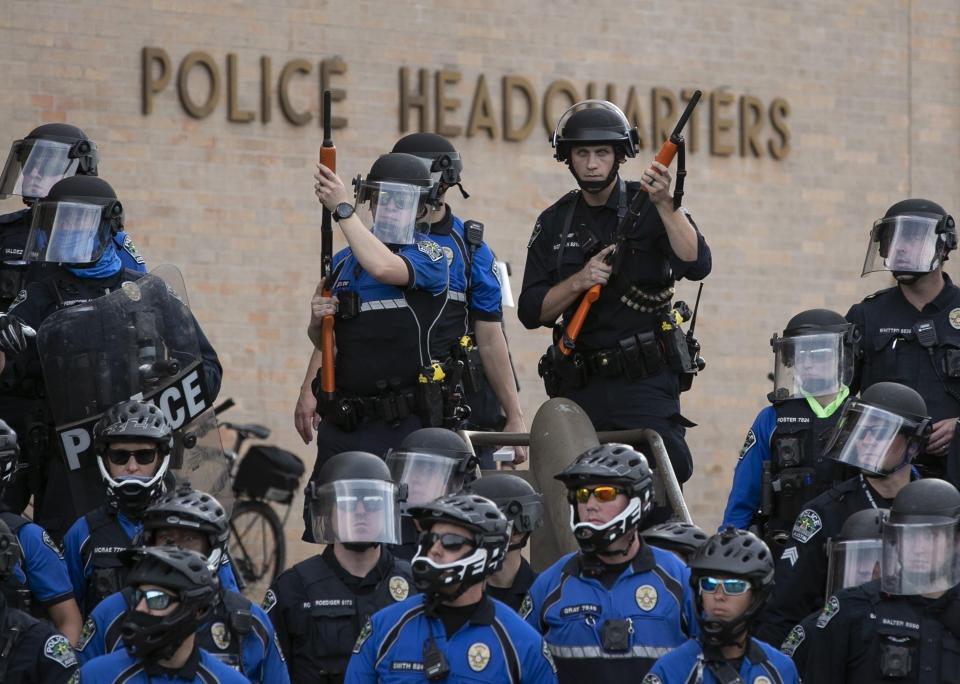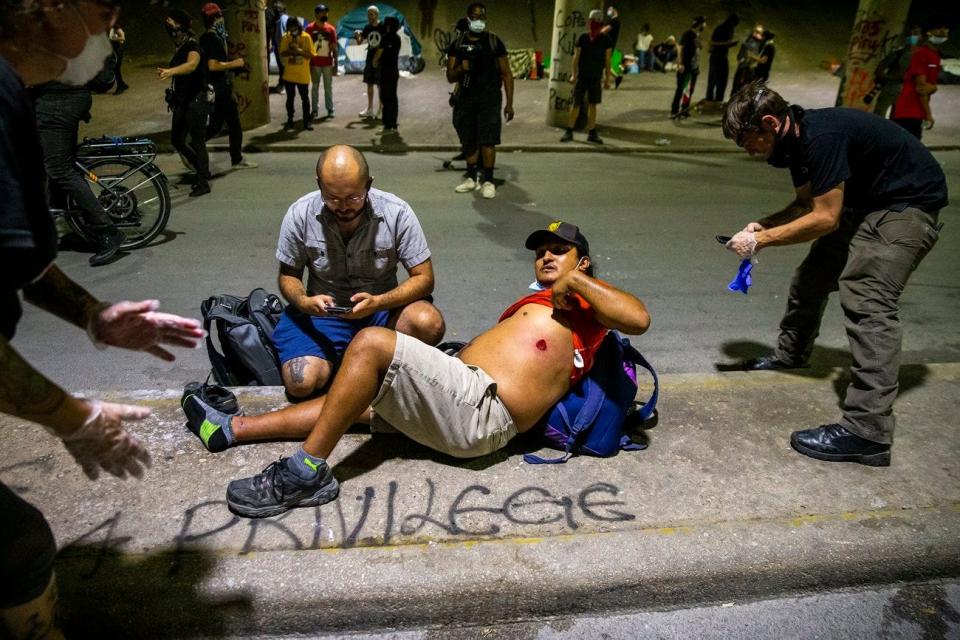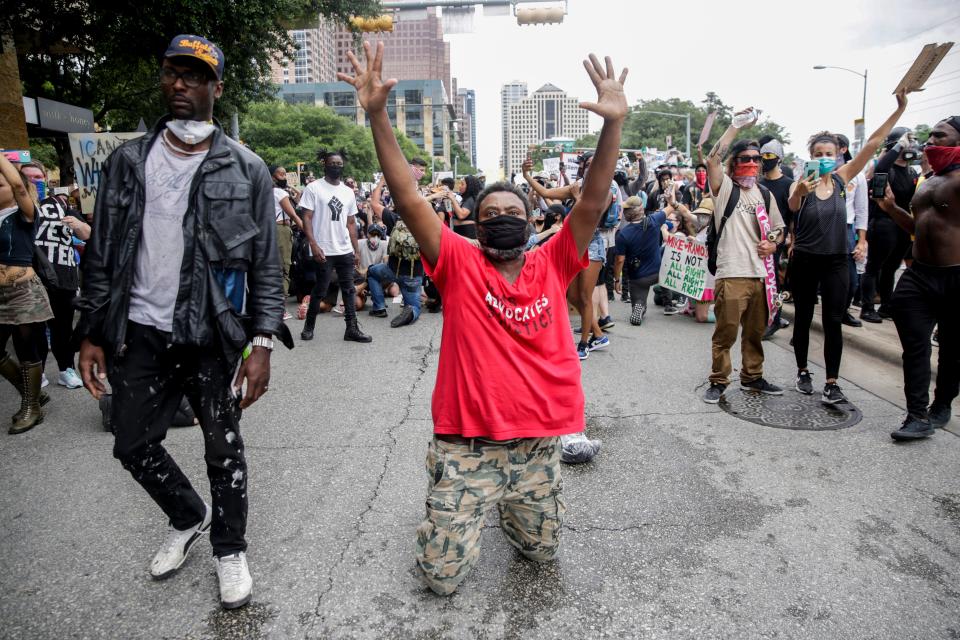EXCLUSIVE: APD report says higher-ups knew of projectile dangers before 2020 protests
Austin police Sgt. Steven Willis sat in an interview room in September with two detectives conducting a broader investigation of the department’s response to the May 2020 Black Lives Matter protests. He described how he was sickened when he witnessed bashed and bloodied demonstrators near the Police Department's headquarters.
The reason: The department's "less lethal" beanbag rounds had not performed as expected, he told them. Records and interviews show the department knew it had a potential problem at least five months before the protests.
“I see people walking by holding injuries, bleeding, and my first thought was, ‘Oh, my god, we never changed the round,’” Willis told special investigations unit detectives, according to a transcript. “So then later I see pictures of the rounds and the wounds that emergency room doctors or surgeons were pulling out of people, and … I just got sick. I got sick to my stomach knowing that I played a part in this.”

In January 2020, Willis and at least one other department midlevel supervisor at the police training academy tried to warn their supervisors that “less lethal” projectiles might be causing greater injuries than expected, according to a confidential report produced within the Austin Police Department last fall and obtained by the American-Statesman. The report said that, based on an investigation that included archived emails and five interviews, “it is reasonable to believe that there were, at least, verbal communications regarding concerns up to the command level.”
“There is evidence to believe that the Austin Police Department had knowledge, information and data indicating there was a problem with the age, condition and accuracy of the 12-gauge less lethal round prior to and leading into the 2020 riots,” the report, written in late 2023 by Detectives Benjamin Hart and Rheannon Cunningham, concluded.
The revelations reignite questions about a dark chapter in Austin policing, when more than a dozen demonstrators were wounded by projectiles that police fired when they said they were met with violence from protesters. Some, including unintended targets, were left with permanent wounds that included traumatic brain injuries. The city has since settled civil lawsuits brought by protesters for about $20 million. Mayor Kirk Watson and Travis County District Attorney Jose Garza in December asked the U.S. Justice Department to investigate.
The report added, “This knowledge of potential deficiencies in performance and accuracy of 12 gauge less lethal munitions discovered by the APD training academy does not appear to have been disseminated to the department as a whole; or specifically to officers on patrol utilizing this equipment on a day to day basis.”

The report sparks new concerns about what the department knew about the munitions, and what officials did to examine their performance after the protests. The department renewed the investigation last fall to focus on the munitions – months after the statute of limitations expired on the three-year anniversary of the protests for Garza to potentially bring an indictment against the city. Those charges could have included recklessly disregarding the risk of deadly conduct.
It also came as city officials and Garza were in discussions about how the city would address concerns that prosecutors had raised about its actions as a government entity. The information from the report is potentially useful to the officers’ defense, which Garza said he considered in dropping all but four of 21 cases in December.
More: Exclusive: DA José Garza drops charges against 17 Austin police officers for 2020 protests
The report obtained by the Statesman does not conclude that the munitions – which police call “beanbag rounds” fired from modified shotguns – were, in fact, defective but formally documented for the first time concerns raised by several employees.
Dicky Grigg, a longtime Austin civil attorney who represented protester Brad Ayala, said he found no information to support the filing of a lawsuit against the maker of the munition or that the munitions had been found to be defective.
The experts "said that if it was outdated, which was one of the allegations, they didn’t see that affecting it in any way, and if it did affect it, that means it was likely not as dangerous and wouldn’t go as far,” he said.
Ayala, who was seen falling to the ground in a viral video after being shot in the head, cracking his skull, received a $2.95 million settlement from the city, but Garza dropped charges against officer Nicholas Gebhart, saying he could not prove the assault case against Gebhart.
Late Wednesday, after the Statesman sought comment from the Police Department, city attorneys issued a confidential “attorney-client privilege” memo to Watson and City Council members about concerns the investigation raised.
In a statement released by Travis County District attorney's office spokesman Ismael Martinez, the DA's office said: "In September 2023, the District Attorney's Office learned that APD would be investigating whether the department knew, prior to May 2020, that the weapons APD officers used during the protests were capable of causing and had caused serious injury. Like many in our community, our office is troubled by both the conclusions of this investigation as well as its timing."
In a statement, the Police Department said: “The Austin Police Department’s special investigations unit investigates all criminal allegations against APD officers. Due to the open and ongoing criminal cases being prosecuted by the Travis County District Attorney, APD is not able to provide any additional information.”
What the report reveals
According to the new report, Willis and now-retired Cpl. William Mercado, who consulted for another company that sold similar munitions, became concerned in 2019 that the rounds in the department’s arsenal were not working properly.
They performed tests on the devices in September 2019, the report indicates, photographed results and provided their observations to their supervisors. The report reviewed by the Statesman does not say what, if anything, happened next.
Their concerns intensified in January 2020 after what they documented as an “over-penetration incident” in which a man was more severely wounded than expected in his right shoulder, requiring “surgical intervention,” the report said.

The document stated that Mercado called the company that makes the projectiles and “was told that the manufacturer would not guarantee the round after 5 years.” The report notes that the expiration date was not marked on each box of projectiles, making it impossible to know the age, and that the department had no system to know the age or to switch out rounds.
During his Sept. 21 interview with investigators, Willis said he is still troubled more than three years later about what happened and wonders whether the injuries could have been prevented.
“Either out of malfeasance, ignorance, laziness, I mean, there’s a lot of adjectives we can use to describe this,” Willis said. “But in the end, we’ve got people with permanent injuries, debilitating injuries, and we’ve got officers that have been indicted.”
“Was the department just not going to ever look at it? This is the first time I’ve sat in front of investigators and talked about this. We’re talking three years later,” he said.
What sparked the latest review?
Officers fired 700 projectiles during the protests. Concerns about the munitions prompted police officials to stop using them after the first weekend of protests. Meanwhile, speculation has persisted for three-and-a-half years within the department about whether a defect caused more extensive protester injuries.
An after-action report released by the department in September 2022 acknowledged that “while the use of this less lethal impact munition is generally regarded as an appropriate individual incapacitation tool, it became clear that the beanbag munition did not perform as expected resulting in unintended injuries.”
But that report did not address the department’s knowledge of those concerns prior to the protests – or examine why it believed the projectiles did not perform “as expected.”
In August, just as she was preparing to take over the department, interim Police Chief Robin Henderson banned the use of beanbag rounds and “less lethal shotguns” until police leaders and prosecutors can better understand how the weapons are used and under what circumstances they could result in prosecutions against officers. The ban remains in place.
According to the new report, Assistant Police Chief Jeff Greenwalt, who serves as the department’s chief of staff, requested the investigation last fall. It says city lawyers asked Greenwalt to testify in an upcoming deposition, and that, as he began studying materials related to the protests, he saw information indicating officers had expressed concerns about the munitions.
The report said Greenwalt realized that the department might have information about those concerns dating back to 2019 that it had not shared with prosecutors.
The findings came as city officials and Garza were working discussing the aftermath of the protests, including their request for the Justice Department review.
In a statement, Doug O’Connell, who represents several of the indicted officers, said Garza's continued prosecution of the remaining officers "seems intentionally designed to undermine confidence in the police department for his own political gain.”
Ken Ervin, who also represents multiple officers indicted after the protests, added, “While this is undoubtedly an issue APD and the city of Austin will need to address, it is unjust and an abuse of power for DA Garza to continue keeping officer (Chance) Bretches and officer (Jeffrey) Teng under indictment.”
This article originally appeared on Austin American-Statesman: APD higher-ups knew of 'less lethal' projectile dangers, report says

